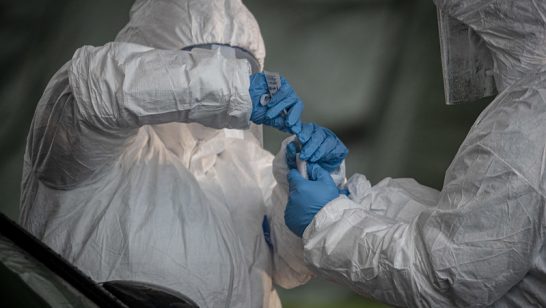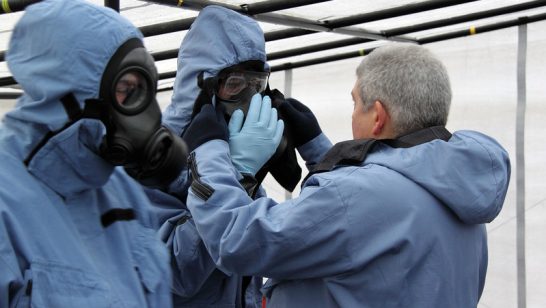
Representatives of the 193 State Parties to the Chemical Weapons Convention (CWC) will gather from 15 to 19 May for their Fifth Review Conference (RC-5). This Review Conference is a particularly important one: the Organisation for the Prohibition of Chemical Weapons (OPCW) – the international organisation tasked with implementing the CWC – is in a period of strategic re-emphasis. Verifying the destruction of declared chemical weapons (CW) stockpiles has been a core task of the OPCW’s work, and this is coming to an end as the United States, the last remaining possessor State, winds down its destruction efforts in September.
This strategic re-emphasis is often framed as one that seeks to rebalance OPCW resources toward preventing the re-emergence of chemical weapons insofar as existing declared stockpiles have now almost been eliminated, and previously committed resources toward this goal can be repurposed. However, amidst the longstanding political polarisation arising from the use of CW in Syria and elsewhere, including Iraq, Malaysia, the United Kingdom, and the Russian Federation, the Fourth Review Conference (RC-4) in 2018 failed to generate any strategic consensus outcome for the OPCW. For many, RC-5 will be a repeat of this failure. However, given the pressing need for strategic re-emphasis, thinking about how we may conceive of a ‘success’ at RC-5 has become more salient as State Parties across all five regional groups seek to salvage something positive. To that end, State Parties should pursue agreements on individual issues likely to command consensus rather than seeking to adopt a watered-down consensus final document with little vision or impetus to shape the future.
Indeed, as indicated in the more detailed report “Preparing for Success at the Fifth Review Conference of the Chemical Weapons Convention”, this ‘Plan B’ approach may not be traditionally understood to be the ideal outcome. However, in the particular contexts of RC-5 it does provide a concrete way for State Parties to work together to establish ‘issue safe spaces’ to deliver outcomes that will reflect more traditional concepts of success.
Plan A: Unlikely
The traditionally ideal outcome, or Plan A, would be the adoption of a substantial and strategically-oriented outcome document agreed upon by consensus. Such an outcome has not been possible since RC-3 in 2013.
The preparatory work of the Open-Ended Working Group for the Preparation of RC-5 (OEWG-RC) has sought to facilitate an overarching consensus. However, this requires all State Parties to work together in good faith, at least a year in advance of the review conference. Yet, the nature of the divisions suggests that the compromise and cooperation required to find consensus, facilitated through the work of the OEWG-RC, would require significant and public U-turns from long-standing and entrenched geopolitical positions. Therefore, while Plan A is desirable, it is unrealistic given that State Parties are unlikely to shift and align their divergent positions, on issues such as the use of CW in Syria, to facilitate a substantive consensus outcome.
As a result, a diluted Plan A may also materialise as a ‘lowest-common-denominator’ consensus outcome report that omits and avoids references to problematic issues. Given how long-standing and important these issues are to many State Parties, these omissions and their linkages to other issues would likely gut the outcome document beyond any measurable value. For example, it would remove explicit references to the use of chemical weapons, and the significant results achieved toward attributing their use, potentially then removing substantive language around the Investigation and Identification Team, fact-finding, potential programmes of work for the new Centre for Chemistry and Technology in particular around chemical forensics, and other areas. Due to the ‘nothing is agreed until everything is agreed’ approach to agreeing on a final document, a watered-down Plan A essentially becomes a race to the bottom. This may be a desirable outcome for a small number of State Parties, including Syria, but would likely cross one or more red lines for the majority.
Plan B: Salvaging a win-win?
A Plan B could be developed that would preserve as much of the discussion and findings of the OEWG-RC review process and RC-5 as possible. A Chairperson’s Report (produced by the Chair-designate Ambassador Henk Cor van der Kwast of the Netherlands) that contains the major developments in CWC implementation and reflects RC-5 review process deliberations would accomplish this and is an important part of Plan B. As so far described, however, the Chairperson’s report alone would not be enough to guide the work of the OPCW over the next quinquennial period as it is non-binding on States Parties. Such an outcome would also be a reflection of stagnation because it would be a re-run of RC-4 in 2018.
However, States Parties can compensate for this shortcoming by identifying areas of agreement and adopting decisions by consensus on specific bounded areas of strategic importance for CWC implementation. One or more separate, limited, forward-looking decisions would complement the Chairperson’s Report and provide binding and authoritative strategic guidance.
Which issues could be covered by one or more consensus Review Conference decisions?
One issue of strategic importance concerns the CWC’s verification regime. With the verified destruction of declared CW stockpiles coming to an end later this year, industry verification will require increased attention. Given the growing number of chemical production facilities, the Technical Secretariat (TS) has indicated that current selection methodologies and processes for industry inspections may have decreasing viability. To this end, some State Parties have expressed the need for clear guidance on the operationalisation of the industry verification system in the future. A consensual decision at RC-5 could note the desire of State Parties to strengthen the verification regime and agree to establish a process to facilitate the evolution of the verification system to ensure continued compliance with the CWC while not overburdening States Parties with large chemical industries.
Related to this, State Parties have been increasingly aware of the need to ensure that the OPCW remains fit for purpose as it transitions away from its prolonged focus on destruction. A crucial element of this is maintaining destruction expertise and building the OPCW’s role as the global repository of CW-related knowledge while also attracting new skills and fostering new programmes of work. RC-5 is an opportunity for State Parties to signal the need to develop a process to evaluate and review how best to achieve these complex organisational needs. One or more decisions that pick up on elements of strengthening the organisational governance of the OPCW, such as establishing a formal review process for the tenure policy and geographic representation, would be an important step to ensure that the TS continues to be able to efficiently and effectively implement the CWC.
State Parties are increasingly thinking about which programmes of work can strengthen efforts to prevent the re-emergence of CW. The OPCW’s support of global anti-terrorism efforts could play an important role in this regard, as the threat posed by chemical terrorism and non-state actors has become more salient since the entry into force of the CWC in 1997. The OPCW has evolved to address such concerns, and RC-5 is well-placed to provide a renewed strategic emphasis as part of a wider focus on the OPCW’s international cooperation and assistance programmes. One or more decisions that focus on training and capacity building for chemical safety and security, first responders, and regional cooperation could be important.
Connected to this, State Parties will be keen to ensure that the newly inaugurated Centre for Chemistry and Technology is strategically embedded within the evolving work of the OPCW. Developed through voluntary donations and with a vast potential to support many existing and new programmes of work, decisions that provide guidance for funding, staffing, and programmatic planning would profoundly benefit all State Parties.
More broadly, the role of gender in multilateral processes has become increasingly recognised over the last decade. While the TS has been actively improving gender parity in the workplace, RC-5 provides an opportunity for State Parties to reaffirm their commitment to gender equality, apply a gender perspective to future activities, and recognise the gendered impacts of chemical weapons. A decision incorporating these elements can strengthen a range of work, from capacity building, assistance and response, to victim support. This issue will be a disappointing loss for States Parties on all sides of the divisions if omitted by default due to the collapse of any meaningful outcome document.
The collective effort now to deliver pockets of consensus on specific issues will sow benefits that the OPCW can reap in the future. Alexander Ghionis
Even if an ideal RC-5 outcome is not possible to achieve, State Parties can collectively lay the groundwork for the OPCW to work together to shape the evolution of the implementation of the CWC. The collective effort now to deliver pockets of consensus on specific issues will sow benefits that the OPCW can reap in the future – a future in which, hopefully, the political context may be more favourable.
The opinions articulated above represent the views of the author and do not necessarily reflect the position of the European Leadership Network or all of its members. The ELN’s aim is to encourage debates that will help develop Europe’s capacity to address the pressing foreign, defence, and security policy challenges of our time.
Image: Flickr, OPCW



